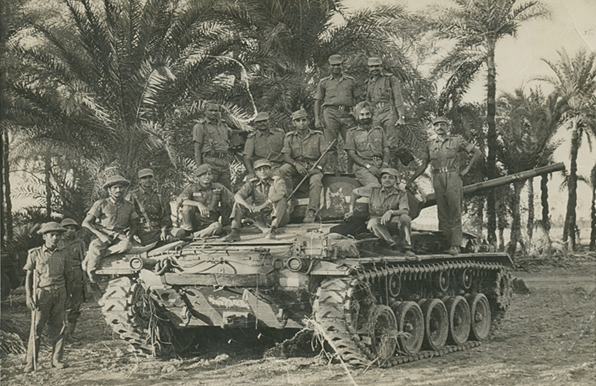Today is the Golden Jubilee of ‘Battle of Garibpur’ fought in 1971 as a precursor to the 1971 Bangladesh Liberation War. Not many know or have heard about the war but its importance in the grander scheme of things cannot be understated. Before the war was officially announced on December 2, 1971, the Indian forces fought on the eastern front and demoralized the Pakistani forces. Moreover, the battle was fought barely 100km from Kolkata. No battle has ever taken place this close to a city and probably will never.
In the early hours of November 21, the 14th Punjab Regiment (Nabha Akal), supported by PT-76 tanks from 45 Cavalry and Mukti Bahini moved in to capture the areas around Garibpur inside Pakistani territory. Mukti Bahini, the rebel forces in Bangladesh, trained by India had already shown the Pakistani forces that they were no mere pushovers.
Mitro Bahini moving into the attack
Taking the rebels into confidence, the Indian Army forged the Mitro Bahini (Allied forces). However, the Indian allied forces were facing Pakistan’s 107 Infantry Brigade’s 6th and 21st Punjab battalions, supported by 49th and 55th Field Regiments (artillery) and 3 Independent Armoured Squadrons (Chaffees).
The massive tank regiment posed a stiff challenge and could have potentially deflated any other ordinary armed forces, however, not so much the Indian forces.
The move was supposed to be a surprise, but following a skirmish with patrol troops of both armies the previous day, Pakistan was alerted to this impending attack. They moved their American tanks toward Garibpur while the Indian forces, in the dark and foggy night, prepared for a counter-attack.
The attack at the first light of dawn
The first attack came at 6 am and the Squadron Commander of ‘C’ Squadron 45 Cavalry Major D. S. Narang was well prepared. He had skillfully deployed his PT-76 light tanks to defend the newly captured areas.
The much inferior PT-76 tanks, with little to no armor, proved to be a handful. The agility of the tanks meant that the bulky Chaffees had a hard time tracking their positions. Moreover, the Indian forces, led by superior leaders displayed astute positional awareness, cornering the opposition into a tiny space.
An Indian Army officer was quoted as saying by TOI, “The Pakistani side had US-made Chaffee tanks and attacked Indian positions. The Indian light tanks were not considered a match for the far more advanced Chaffees. The Pakistani infantry was also supported by heavy artillery. There was a close-quarter battle through the night and the Pakistanis were forced to retreat by the morning of November 22. They left behind 11 destroyed Chaffee tanks and three in running condition.”
Pakistan pressed the panic button
Seemingly losing the battle, Pakistan immediately pressed the panic button and called for its fragile Air Force to bail out its battered Tank regiment. Around 3 PM, three F-86 Sabres were deployed by the Pakistan Air Force (PAF) to combat the bolstered Indian allied forces.
However, India had already taken into consideration of an aerial fight and immediately dispatched four Folland Gnats- a British compact swept-wing subsonic fighter aircraft to intercept the timid PAF attack.
The Sabre killers
The IAF Gnats brought down two of them over Bongaon and forced another one to fly back. No IAF aircraft were lost and in the first aerial duel between the two countries, Pakistan was left nursing its deep wounds. Such was the psychological damage that Pakistan didn’t dare use airforce in the war to come in 20 days time.
Such was the terror of IAF Gnats that in army folklore, the aircraft is now referred to as the ‘Sabre Killers’. Flight Lieutenant M.A. Ganapathy and Flying Officer Donald Lazarus led the Gnat section while MIGs were flown by formation leader Flight Lieutenant Roy Andrew Massey and Flying Officer S.F. Soarez.
What stood out was the fact that a single battalion had been able to destroy an entire Pakistani brigade supported by an air force and artillery. This and victories in other battles nearby like the Battle of Hilli ensured that the Northern sector of East Pakistan was virtually in the hands of Mitro Bahini before the war was declared.
A victory against the odds
India and Bangladesh were victorious in the battle, and Pakistan ran away with the tail between its legs. 8 Chaffee tanks were demolished while 3 tanks were taken into possession by India. However, that is not to say India didn’t suffer any casualties. Joint Commander Lt Col TS Sidhu was badly injured while Major Daljit Singh Narang was martyred while fighting the enemy. He was awarded the country’s second-highest wartime honour, the Maha Vir Chakra.
A movie regarding the ‘Battle of Garibpur’ titled ‘Pippa’, is in the offing based on the book ‘The Burning Chaffees’, written by Brig Balram Singh. The movie is being produced by Ronnie Screwvala and Sidharth Roy Kapur with actor Ishan Khatter set to star in it. People need to know that against the odds and back stacked against the wall, the Indian forces dared to do the unthinkable. It not only took on the unthinkable but also emerged proudly victorious.
